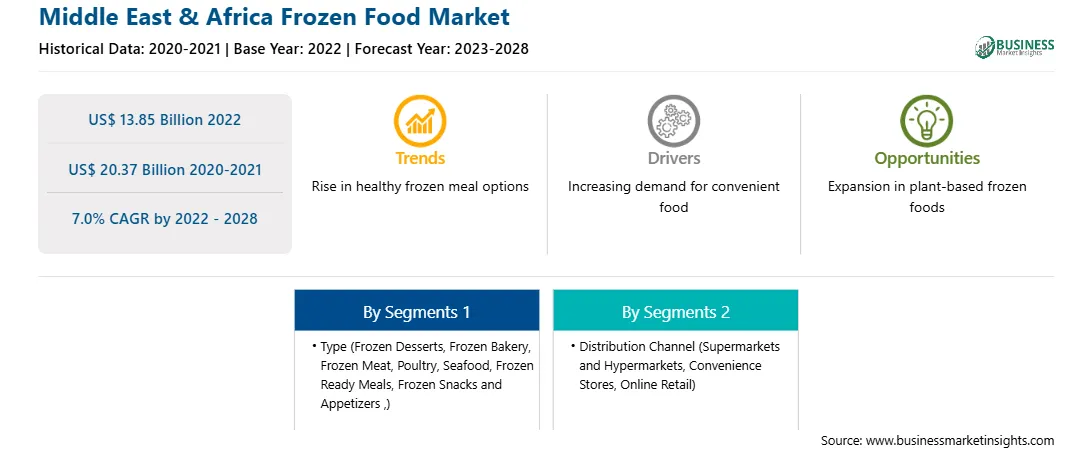The frozen food market in the Middle East & Africa is expected to grow from US$ 13.85 billion in 2022 to US$ 20.37 billion by 2028; it is estimated to grow at a CAGR of 7.0% from 2022 to 2028.
The burgeoning popularity of plant-based frozen products is the major factor driving the growth of the Middle East & Africa frozen food market. Veganism has gained significant traction in recent years. Consumers are highly inclined toward plant-based products as they perceive them to be healthier than conventional products. Additionally, increasing awareness regarding animal protection and environmental sustainability is adding to the popularity of these food products. Registrations for the Veganuary Campaign have increased dramatically over the past few years. Thus, manufacturers of frozen food are launching plant-based products to catch up with the flourishing trend of veganism. For instance, in 2020, Lazy Vegan, a Dutch start-up, released its latest frozen ready meal—gluten-free and soy-free Thai Green Curry. Thus, the growing inclination toward plant-based food, with the popularity of veganism, is expected to bring new trends to the frozen food market in the Middle East and Africa during the forecast period.
Middle East & Africa Frozen Food
Market Revenue and Forecast to 2028 (US$ Billion)
Strategic insights for the Middle East & Africa Frozen Food provides data-driven analysis of the industry landscape, including current trends, key players, and regional nuances. These insights offer actionable recommendations, enabling readers to differentiate themselves from competitors by identifying untapped segments or developing unique value propositions. Leveraging data analytics, these insights help industry players anticipate the market shifts, whether investors, manufacturers, or other stakeholders. A future-oriented perspective is essential, helping stakeholders anticipate market shifts and position themselves for long-term success in this dynamic region. Ultimately, effective strategic insights empower readers to make informed decisions that drive profitability and achieve their business objectives within the market. The geographic scope of the Middle East & Africa Frozen Food refers to the specific areas in which a business operates and competes. Understanding local distinctions, such as diverse consumer preferences (e.g., demand for specific plug types or battery backup durations), varying economic conditions, and regulatory environments, is crucial for tailoring strategies to specific markets. Businesses can expand their reach by identifying underserved areas or adapting their offerings to meet local demands. A clear market focus allows for more effective resource allocation, targeted marketing campaigns, and better positioning against local competitors, ultimately driving growth in those targeted areas.Middle East & Africa Frozen Food Strategic Insights

Middle East & Africa Frozen Food Report Scope
Report Attribute
Details
Market size in 2022
US$ 13.85 Billion
Market Size by 2028
US$ 20.37 Billion
Global CAGR (2022 - 2028)
7.0%
Historical Data
2020-2021
Forecast period
2023-2028
Segments Covered
By Type
By Distribution Channel
Regions and Countries Covered
Middle East and Africa
Market leaders and key company profiles
Middle East & Africa Frozen Food Regional Insights

Middle East & Africa Frozen Food Market Segmentation
The Middle East & Africa frozen food market is segmented into type, distribution channel, and country. Based on type, the frozen food market is segmented into frozen desserts; frozen bakery; frozen meat, poultry, and seafood; frozen ready meals; frozen snacks and appetizers; others. The meat, poultry, and seafood segment are projected to register the largest share during the forecast period. Based on distribution, the frozen food market is segmented into supermarkets and hypermarkets, convenience stores, online retail, and others. The online retail segment is projected to register the highest CAGR in the market due to its shopping and product delivery convenience. Based on country, the Middle East & Africa frozen food market is segmented into Saudi Arabia, South Africa, UAE, and the Rest of Middle East & Africa. The Rest of Middle East & Africa held the largest market share in 2022.
Bonduelle Group; General Mills; Kellogg’s Company; McCain Foods Limited; Nestle S.A.; The Kraft Heinz Company; and Tyson Foods, Inc. are among the leading companies in the frozen food market in the region.
The Middle East & Africa Frozen Food Market is valued at US$ 13.85 Billion in 2022, it is projected to reach US$ 20.37 Billion by 2028.
As per our report Middle East & Africa Frozen Food Market, the market size is valued at US$ 13.85 Billion in 2022, projecting it to reach US$ 20.37 Billion by 2028. This translates to a CAGR of approximately 7.0% during the forecast period.
The Middle East & Africa Frozen Food Market report typically cover these key segments-
The historic period, base year, and forecast period can vary slightly depending on the specific market research report. However, for the Middle East & Africa Frozen Food Market report:
The Middle East & Africa Frozen Food Market is populated by several key players, each contributing to its growth and innovation. Some of the major players include:
The Middle East & Africa Frozen Food Market report is valuable for diverse stakeholders, including:
Essentially, anyone involved in or considering involvement in the Middle East & Africa Frozen Food Market value chain can benefit from the information contained in a comprehensive market report.